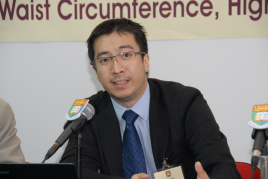Media
First Liver Health Population Study Shows
Over 40% of Healthy HK People Have
Non-alcoholic Fatty Liver Disease
Higher Waist Circumference, Higher Risk
16 Aug 2012
Fatty liver disease (the accumulation of fat inside the liver cells) may lead to cirrhosis and increase the risk of having liver cancer. Western medicine believes that drinking alcohol and hepatitis C infection are the major risk factors for fatty liver disease. However, healthy people without such risk factors will still have fatty liver, non-alcoholic fatty liver disease (NAFLD) refers. To find out the prevalence of NAFLD in Hong Kong and the associated risk factors, The University of Hong Kong Li Ka Shing Faculty of Medicine collaborates with Hong Kong Liver Foundation and Hong Kong Red Cross Blood Transfusion Service to conduct the first ever large population study on liver health named “The Liver Health Census Study”. Study results show that 42% of Hong Kong people have NAFLD and interestingly, higher waist circumference is the most important risk factor. It is also found that male and female with more than 33 inch and 29 inch waist circumference respectively have 5 times higher risk of developing NAFLD compared with those with waist circumference below these values.
Principal Investigator of the study, Professor YUEN Man-fung, Li Shu Fan Medical Foundation Professorship in Medicine, Clinical Professor of Department of Medicine, The University of Hong Kong Li Ka Shing Faculty of Medicine says, “The study result is both surprising and alarming. Local people are advised to be more alert to their liver health, it can be achieved by having a simple assessment of your own waist circumference. Based on the data of our study, the new optimal waist circumference cut-off for male and female should be 33 inch (84cm) and 29 inch (74cm) respectively.”
About Liver Health Census Study
In the study, 2,493 healthy volunteers from the general population were recruited through Hong Kong Red Cross Blood Transfusion Service between August 2010 and March 2012. All subjects underwent liver ultrasound scan, fibroscan of the liver, blood testing for fasting glucose and cholesterol, and liver function tests. All subjects were screened negative for hepatitis B and C infection and reported no significant alcohol intake. Measurements of weight, height, waist and hip circumferences, and blood pressure were also performed. A detailed questionnaire was also carried out.
Higher the waist circumference, higher the chance of having NAFLD
Among the 2,493 healthy volunteers, 42% (1,054) had NAFLD. Males from the ages of 26 to 55 have higher prevalence compared to females. Severe fatty liver is found to associate with higher waist circumference, higher fasting glucose and cholesterol levels, and higher systolic blood pressure. Among all these factors, waist circumference is the most important risk factor.
The data of the study shows that the higher the waist circumference, the higher chance of having NAFLD. Among all subjects, about 85% of male with 35 inch or above (>89cm) waist circumference and female with 31 inch or above (>79cm) waist circumference are identified to have mild to severe NAFLD, which means people with higher waist circumference have very high chance of having NAFLD. Fortunately, only 1.2% of subjects with NAFLD have evidence of significant liver fibrosis and 0.17% have cirrhosis.
New optimal waist circumference cut-off
The study suggests the new optimal waist circumference cut-off should be 33 inch (84cm) for male and 29 inch (74cm) for female, while the current recommendations by the Department of Health are 36 inch (90cm) for male and 32 inch (80cm) for female. It is also found that male and female with more than 33 inch and 29 inch waist circumference respectively (i.e. higher than the new optimal cut-off suggested by this study) have 5 times higher risk of developing NAFLD compared with those with waist circumference below these values.
Dr LEE Cheuk-kwong, Consultant of Hong Kong Red Cross Blood Transfusion Service says, “The present study has indicated many people are at risk of NAFLD. With the society and lifestyle changes, we recommend that the current standard suggested by the Department of Health may be too loose, and the newer waist targets should be implemented to facilitate the reduction of the chance of NAFLD by adopting lifestyle changes.”
Mr YU Kam-kee BBS, MBE, JP, Chairman of the Hong Kong Liver Foundation adds, “The high prevalence of NAFLD in Hong Kong may lead to a high rate of cirrhosis and its complications in the near future, which will bring to heavy burden to the healthcare system in Hong Kong. So, it is important to raise public awareness on NAFLD for better disease control and prevention.”
About the research team
The research is a collaborative project by the Department of Medicine of The University of Hong Kong Li Ka Shing Faculty of Medicine, Hong Kong Liver Foundation, and Hong Kong Red Cross Blood Transfusion Service. Professor YUEN Man-fung and Dr. James FUNG Yan-yue of Department of Medicine, HKU are the principal investigators of the study.
Please visit the website at http://www.med.hku.hk/v1/news-and-events/press-releases/ for press photos and PowerPoint slides.
(from left) Ms MAN, a subject who joined the study and diagnosed with fatty liver; Mr YU Kam-kee, BBS, MBE, JP, Chairman of the Hong Kong Liver Foundation; Professor YUEN Man-fung, Li Shu Fan Medical Foundation Professor in Medicine, Clinical Professor of the Department of Medicine, The University of Hong Kong Li Ka Shing Faculty of Medicine; Dr James FUNG Yan-yue, Honorary Clinical Assistant Professor of the Department of Medicine, The University of Hong Kong Li Ka Shing Faculty of Medicine and Dr LEE Cheuk-kwong, Consultant of the Hong Kong Red Cross Blood Transfusion Service
.
Dr LEE Cheuk-kwong, Consultant, Hong Kong Red Cross Blood Transfusion Service said many HK people are at risk of NAFLD, so the newer waist targets should be implemented to facilitate the reduction of the chance of NAFLD.






